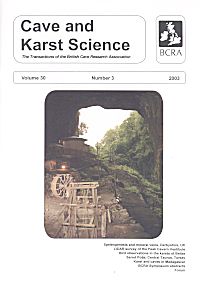 |
- Speleogenesis and mineral veins, Derbyshire, UK
- LIDAR survey of the Peak Cavern Vestibule
- Bird observations in the karsts of Belize
- Sariot Polje, Central Taurus, Turkey
- Karst and caves in Madagascar
- BCRA Symposium abstracts
- Forum
Cover photo by Paul
Deakin, © reserved:
The entrance of Peak Cavern ("The Devil's Arse"),
Castleton, Derbyshire, is the largest cave entrance in the British Isles. A 3D
digital CAD model of the entrance chamber (the Vestibule) was presented in Cave
and Karst Science Vol. 29 (2), and the results of a re-survey of the Vestibule
using ground LIDAR (Light Detection And Ranging) equipment is reported in the
present issue. In the foreground are the rope-walk benches, which date back
over 400 years, and a rope making demonstration forms part of the present day
show-cave tour. Water from the cave discharges via an underflow spring, but in
times of flood the waters back up and flow down the channel at the bottom right
of the photograph. |

